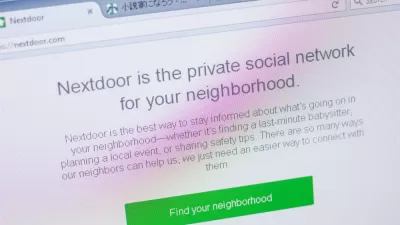Communities have a growing number of technological resources available to face the challenges posed by a growing population and a resource constrained world.

From the day our government came into existence, there have been large challenges to overcome, whether governing just one city or an entire country. From providing disaster relief, to managing public transportation and roads, to leading the way for more sustainable community development, the government has a lot to focus on.
But if there is one thing we the people are really good at, it’s finding innovative solutions to tough problems. We the people are in a constant state of self-reflection, always asking: "How can we make our government more effective, more open, and more efficient? What role can we play in pushing our government to serve us better?"
Over the last several decades, a technological boom has changed the face of the planet. Just as it has changed everyday life, so too has it changed the way our country is governed. Let’s look at a few of the problems we are currently reflecting on—and the technological solutions that could turn them around:
Problem 1: Civic Unrest
Civic unrest is becoming the norm in nations around the world. In the United States, Congressional approval ratings are at an all-time low, thanks to last summer’s government shutdown and frequent bipartisan gridlock over healthcare and other initiatives.
Technology’s Solution: The permeation of mobile devices allows us to participate in politics and boost civic engagement in new ways. President Obama now regularly holds Twitter town halls, inviting questions under the hashtag #AskObama. A full 84 percent of local governments now have a social media presence. Additionally, 84 percent of Congressional representatives are registered on Twitter, and 90 percent are on Facebook.
With the use of social media now mainstream across government agencies, communicating with our legislators has never been easier—and with government organizations embracing more technologies such as streaming video and mobile apps that enable easier sharing, the ability to communicate more frequently and easily will continue to improve.
Problem 2: Dollars Speak Louder Than Words
Most politicians running for office receive campaign donations from major corporations—many amounting to millions of dollars—and they use this money to promote themselves and get elected. The problem? The deal often means politicians must bend to the interests of Big Money instead of the Little Guy.
Technology’s Solution: Plenty of government entities are now turning to cloud and mobile solutions to connect with citizens and allow them a platform to voice their concerns—therefore taking the power away from the big money and leveling the playing field. As mobile technology reaches critical mass, the ability of citizens to affect legislative change does, too.
Some cities are already adopting these new technologies on a local level. Take Austin, Texas, for example: The city recently implemented an online platform for civic engagement, Speak Up, Austin! More than 3,105 registered users have submitted more than 995 ideas, cast 10,120 votes, and added 3,042 comments. Austin has already implemented 26 publicly-brainstormed ideas in the city, and more than 65 are in action.
Problem 3: The People Feel Powerless
Citizens feel they have little influence over government decisions. Government has become a spectator sport, leaving most people with the feeling that the only power they have to contribute is in the voting booth. While voting is an essential form of civic engagement, it is not the only way to make one’s voice heard.
Technology’s Solution: Major tech trends, like cloud and mobile technologies, are impacting civic engagement in a major way. More than half of Americans (61 percent) now own a smartphone for reading the news, staying on top of politics, and sharing information. That means a whopping 137 million Americans have a smartphone—and by 2016, that number is expected to rise to 192 million.
In the city of Santa Rosa, California public officials recently implemented public smartphone access to live and on-demand public meetings. The city saw civic engagement dramatically rise among the public—traffic to meeting videos rose by 3,000 hits in just two months. All of that mobile-enabled civic engagement is good for the city’s wallet, too—Santa Rosa estimates the initiative saved $1,000 per month in staff time.
Problem 4: It’s Hard to Get Involved
Unless you’re a political animal, getting involved in the politics in your town can be tough. Citizens don’t feel empowered to use their skills and abilities to make a difference. Despite the fact most towns and local governments have plenty of boards and commissions for interested citizens to take part, many people just aren’t aware of how they can contribute.
Technology’s Solution: In today’s digital job market, most jobs are found online through job boards and social media. But many towns are still handling applications to boards and commissions on paper. By using an online system to promote and organize board and commission appointments, these opportunities for civic engagement become easier to promote and find.
The city of Stockton, California discovered that by posting digital announcements of openings on boards and commissions, it was much easier for citizens to find opportunities for engagement. With a simple link to the online job posting, the city could post the positions in more places, and citizens could share the opening with others who might be interested. When the city moved their existing process online, more people with the right skills connected to open positions.
Problem 5: It is Difficult for Citizens to Unite to Help Their Government Solve Problems
Solving the problems in any given community often require multiple perspectives. What one person sees as a problem, such as graffiti, crime, or government inefficiency, can be best approached by working in collaboration. The power of a united community is much stronger than one person working alone.
Technology’s Solution: New mobile and social tools means U.S. citizens may finally have an opportunity to unite under common causes, bringing healthy change to their neighborhoods as well as to the nation as a whole. Civic engagement aided by online platforms that allow citizens new forums to voice concerns and hold legislators accountable.
For example, online discussion boards, polls, commenting platforms, live-streaming of video, social media, and e-petitions are just a few ways tech is aiding civic engagement. Consider Change.org, an e-petition platform that’s been wildly successful. Each month, it generates millions of signatures in an effort to create legislative change—and it succeeds. Take, for instance, an open letter to the new planning director of Los Angeles, a petition to allow urban farmers to keep small livestock, or a petition to save a national park in Tanzania. The popularity of e-petitions has even prompted the White House to create its own counterpart, We The People.
Our challenges are many, but our capacity to innovate is endless. In the coming decades, civic engagement will be of utmost importance if we are to move forward as a united nation—and thanks to technology, it will be easier than ever.
Tom Spengler is the CEO and co-founder of Granicus, an award-winning cloud applications provider for government transparency, efficiency, and citizen participation. Connect with Tom and the Granicus team on Twitter and LinkedIn.

Maui's Vacation Rental Debate Turns Ugly
Verbal attacks, misinformation campaigns and fistfights plague a high-stakes debate to convert thousands of vacation rentals into long-term housing.

Planetizen Federal Action Tracker
A weekly monitor of how Trump’s orders and actions are impacting planners and planning in America.

In Urban Planning, AI Prompting Could be the New Design Thinking
Creativity has long been key to great urban design. What if we see AI as our new creative partner?

King County Supportive Housing Program Offers Hope for Unhoused Residents
The county is taking a ‘Housing First’ approach that prioritizes getting people into housing, then offering wraparound supportive services.

Researchers Use AI to Get Clearer Picture of US Housing
Analysts are using artificial intelligence to supercharge their research by allowing them to comb through data faster. Though these AI tools can be error prone, they save time and housing researchers are optimistic about the future.

Making Shared Micromobility More Inclusive
Cities and shared mobility system operators can do more to include people with disabilities in planning and operations, per a new report.
Urban Design for Planners 1: Software Tools
This six-course series explores essential urban design concepts using open source software and equips planners with the tools they need to participate fully in the urban design process.
Planning for Universal Design
Learn the tools for implementing Universal Design in planning regulations.
planning NEXT
Appalachian Highlands Housing Partners
Mpact (founded as Rail~Volution)
City of Camden Redevelopment Agency
City of Astoria
City of Portland
City of Laramie





























